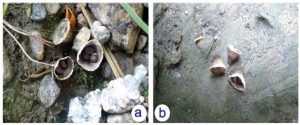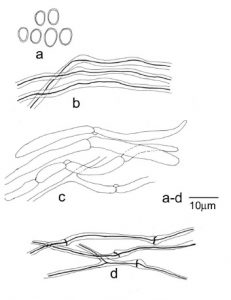Cyathus colensoi Berk., in Hooker, Bot. Antarct. Voy. Erebus Terror 1839-1843, II, Fl. Nov. -Zeal.: 192 (1855) Index Fungorum number: IF 147486
Synonymy: Cyathodes colensoi (Berk.) Kuntze, Revis, gen. Pl. (Leipzig) 2: 851 (1891)
Peridium: 6–7 mm high, 5–6 mm wide at mouth, campanulate, outer surface pallid gray to grayish brown, finely tomentose but glabrous in age, inner surface smooth, pale gray to lightbrown, margin thick, entire; Peridioles: oval to lenticular, gray to blackish, 1.5–2.0 mm diam., attached to the base of peridium by funicular cord, tunica thin; cortex thick, single layered; Basidiospores: 5.6–8.0 × 4.8–8.0 μm, L= 6.8±0.93 μm, W= 6.3±1.07 μm, Q= 0.9–1.0, subovoid to ellipsoid, hyaline, thick walled, smooth, inamyloid; Basidia: not observed; Exoperidial hyphae: 2.4–4.8 μm diam., hyaline to olive green, thick walled; Endoperidial hyphae: 2.4–6.4 μm diam.,, hyaline, septate, branched, clamp connections present; Funiculus hyphae: 1.6–3.2 μm diam., hyaline, bulbous septate, branched.
Materials examined: Jammu and Kashmir, Leh, Phey village, humicolous, gregarious, Rigzin Yangdol and Y. P. Sharma, HBJU–476, 3rd August, 2014.
Distribution: On dead twigs and soil, West Bengal (Sharma 2016).
Notes: The above examined collection has been identified as Cyathus colensoi. Its macroscopic and microscopic characters are in conformity with those given for this species by Sharma (2016) except for some variation in basidiospore size. Sharma (2016) documented the spore size range from 8.5-11.5 × 7.0-8.5 μm as compared to 5.6–8.0 × 4.8–8.0 μm in our collection. Cyathus microsporus is a related species but differs in having smaller basidiospores and peridioles.
FIGURE. a, b Basidiocarps of Cyathus colensoi in natural habitat.

FIGURE. Cyathus colensoi. a Basidiospores. b Exoperidial hyphae. c Endoperidial hyphae.
d Funiculus hyphae.

